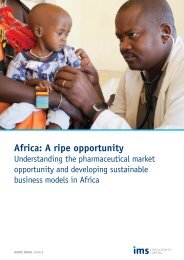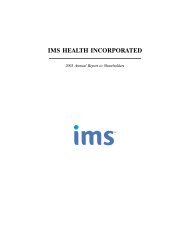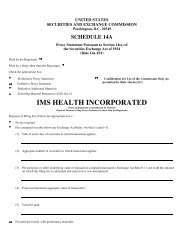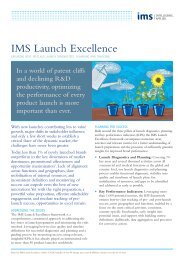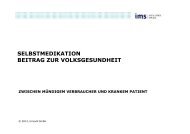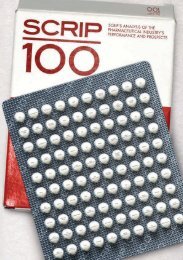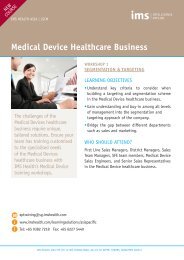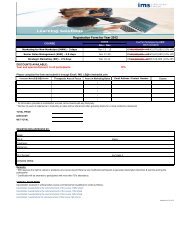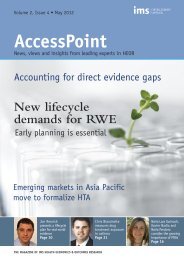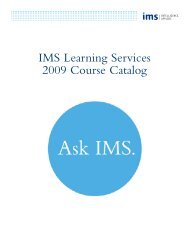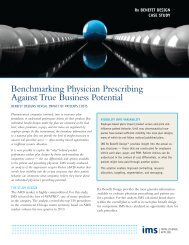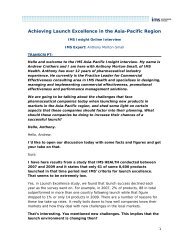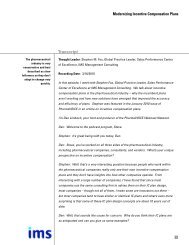The Global Use of Medicines: Outlook - IMS Health
The Global Use of Medicines: Outlook - IMS Health
The Global Use of Medicines: Outlook - IMS Health
You also want an ePaper? Increase the reach of your titles
YUMPU automatically turns print PDFs into web optimized ePapers that Google loves.
Report by the <strong>IMS</strong> Institute for <strong>Health</strong>care Informatics<br />
<strong>The</strong> <strong>Global</strong> <strong>Use</strong><br />
<strong>of</strong> <strong>Medicines</strong>:<br />
<strong>Outlook</strong><br />
Through 2016<br />
July 2012
Key 2016 Numbers<br />
Spending ~ $1.2 Trillion<br />
Spending on Brands $615-645Bn<br />
Spending on Generics $400-430Bn<br />
Developed Country Spending Per Person $609<br />
Pharmerging Country Spending Per Person $91<br />
Key 2012-2016 Numbers<br />
New Molecular Entity Launches 160-185<br />
<strong>Global</strong> Spending Growth CAGR 3-6%<br />
U.S. Spending Growth CAGR 1-4%<br />
Pharmerging Spending Growth CAGR 12-15%<br />
“Patent Dividend” $106Bn<br />
<strong>The</strong> <strong>Global</strong> <strong>Use</strong> <strong>of</strong> <strong>Medicines</strong>: <strong>Outlook</strong> Through 2016<br />
Report by the <strong>IMS</strong> Institute for <strong>Health</strong>care Informatics<br />
<strong>IMS</strong> Institute for <strong>Health</strong>care Informatics<br />
11 Waterview Boulevard<br />
Parsippany, NJ 07054<br />
USA<br />
info@theimsinstitute.org<br />
www.theimsinstitute.org<br />
© 2012 <strong>IMS</strong> <strong>Health</strong> Incorporated and its affiliates.<br />
All reproduction rights, quotations, broadcasting,<br />
publications reserved. No part <strong>of</strong> this publication may be<br />
reproduced or transmitted in any form or by any means,<br />
electronic or mechanical, including photocopy, recording,<br />
or any information storage and retrieval system, without<br />
express written consent <strong>of</strong> <strong>IMS</strong> <strong>Health</strong> and the <strong>IMS</strong><br />
Institute for <strong>Health</strong>care Informatics.<br />
� FIND OUT MORE<br />
If you want to receive more reports from the<br />
<strong>IMS</strong> Institute, or be on our mailing list,<br />
please click here.
Contents<br />
<strong>The</strong> <strong>Global</strong> <strong>Use</strong> <strong>of</strong> <strong>Medicines</strong>: <strong>Outlook</strong> Through 2016<br />
Report by the <strong>IMS</strong> Institute for <strong>Health</strong>care Informatics<br />
Introduction .......................................................... 2<br />
Executive Summary .................................................. 3<br />
<strong>Global</strong> Spending on <strong>Medicines</strong> .................................. 4<br />
Transformations in Disease Treatment ....................... 11<br />
<strong>Global</strong> Spending Growth ......................................... 17<br />
Notes on Sources ................................................. 29<br />
Appendices .......................................................... 30<br />
About the <strong>IMS</strong> Institute ........................................ 33<br />
1
Introduction<br />
<strong>The</strong> future level <strong>of</strong> global spending on medicines underscores the similar challenges <strong>of</strong> access and affordability which face those who<br />
consume and pay for healthcare around the world.<br />
In the developed markets, including the United States and Europe, the current economic downturn will amplify many <strong>of</strong> the long-term<br />
concerns about aging populations afflicted with expensive chronic diseases and the desire by all healthcare stakeholders to control costs.<br />
Across countries, similar policies are already being implemented to rein in spending on expensive therapies, increase the use <strong>of</strong> generics,<br />
address pricing directly through price cuts or indirectly via discounts or rebates, and develop a market for biosimilars as a lower-cost<br />
alternative to original biologics.<br />
Alternatively, the fast growing pharmerging markets will be driven predominantly by economic gains and rising incomes. This rise in<br />
incomes, particularly for the lowest earners, coupled with government commitments to support expanded access to basic healthcare services,<br />
will make medicines more broadly available and affordable to millions <strong>of</strong> people.<br />
Further, new therapies for a range <strong>of</strong> diseases affecting both developed and developing world populations are currently, or will soon become,<br />
available transforming patient care. Despite this progress, however, significant gaps remain in the drug arsenal.<br />
In this report we quantify these factors and examine the spending and usage <strong>of</strong> medicines globally through 2016. We intend this report to<br />
provide a foundation for meaningful discussion about the value, cost and role <strong>of</strong> medicines in healthcare over the next five years. Our report<br />
was developed as a public service without industry or government funding.<br />
Michael Kleinrock<br />
Director, Research Development<br />
<strong>IMS</strong> Institute for <strong>Health</strong>care Informatics<br />
<strong>The</strong> <strong>Global</strong> <strong>Use</strong> <strong>of</strong> <strong>Medicines</strong>: <strong>Outlook</strong> Through 2016<br />
Report by the <strong>IMS</strong> Institute for <strong>Health</strong>care Informatics<br />
2
Executive summary<br />
GLOBAL SPENDING ON MEDICINES<br />
Annual global spending on medicines will reach<br />
nearly $1.2 trillion by 2016, as the pharmerging<br />
markets, biologics and generics contribute more to<br />
spending. In the developed markets, including the<br />
United States, Europe and Japan, spending will<br />
decline to 57% <strong>of</strong> the global total due to expiring<br />
patents for a number <strong>of</strong> significant brand-name<br />
drugs, slower increases in spending on branded<br />
products, and increased cost containment measures<br />
by payers. Alternatively, pharmerging markets will<br />
reach 30% <strong>of</strong> global spending by 2016, as population<br />
and economic growth contribute to dramatically<br />
higher use <strong>of</strong> medicines in these markets.<br />
Overall, the top 20 therapy areas will account for<br />
42% <strong>of</strong> global spending, led by cancer, diabetes and<br />
asthma/COPD.<br />
An accelerated shift to the use <strong>of</strong> generic medicines<br />
is expected, both from an unprecedented level <strong>of</strong><br />
patent expiries in the U.S., and from volume-driven<br />
growth in the largely generic-using pharmerging<br />
markets. At the same time, lower-cost versions <strong>of</strong><br />
expensive biologic medicines, or biosimilars, will<br />
continue to be launched, though slowly, and will<br />
account for only $4-6Bn, or 2%, <strong>of</strong> the $200-210Bn<br />
in spending on biologics by 2016.<br />
By 2016, net spending on medicines, after <strong>of</strong>finvoice<br />
discounts and rebates, will surpass $1 trillion<br />
globally. Off-invoice transactions will continue to<br />
rise, particularly for generics, representing in<br />
aggregate an estimated $180-190Bn in 2016.<br />
<strong>The</strong> <strong>Global</strong> <strong>Use</strong> <strong>of</strong> <strong>Medicines</strong>: <strong>Outlook</strong> Through 2016<br />
Report by the <strong>IMS</strong> Institute for <strong>Health</strong>care Informatics<br />
TRANSFORMATIONS IN DISEASE TREATMENTS<br />
New medicines will transform patient care in a large<br />
number <strong>of</strong> diseases including cancer, heart disease and<br />
central nervous system disorders. Few medicines are<br />
available uniformly to all patients globally following<br />
launch, and the time lag in some countries for gaining<br />
access to these medicines can be significant. Proven<br />
medicines, which were only previously available in a<br />
few countries, will become more widely available over<br />
the next five years, bringing important advances in care<br />
for diabetes, cancer and autoimmune diseases to millions.<br />
<strong>Global</strong> launches for New Molecular Entities (NME)<br />
will rebound, as 32 to 37 NMEs per year are expected<br />
to be launched, through 2016. Innovative therapies<br />
are anticipated for Alzheimer’s and autoimmune<br />
diseases, diabetes, cancer, and infectious, cardiovascular<br />
and respiratory conditions, as well as orphan diseases.<br />
In 2004, the World <strong>Health</strong> Organization reported<br />
that significant gaps existed in pharmaceuticals<br />
available to treat certain priority diseases, and issued<br />
a call to action to address these gaps. In the years<br />
since, significant efforts have been made to address<br />
some <strong>of</strong> these disease areas, though gaps will remain.<br />
GLOBAL SPENDING GROWTH<br />
Annual global spending growth will increase from<br />
$30Bn in 2012, to $70Bn in 2016, driven by volume<br />
growth in pharmerging markets and higher spending<br />
by developed nations. <strong>The</strong> pharmerging countries<br />
will double their spending on pharmaceuticals over<br />
the next five years, as annual growth is forecast to<br />
increase from $24Bn in 2012, to $35-45Bn in 2016.<br />
Spending on medicines in the pharmerging markets<br />
will increase by $150-165Bn, driven by rising<br />
incomes and macroeconomic expansion, and<br />
increasing access to medicines supported through a<br />
range <strong>of</strong> government policies and programs.<br />
<strong>The</strong> developed markets are expected to grow slowly due<br />
to patent expiries and the sustained impact <strong>of</strong> the global<br />
economic crisis felt in these countries since 2008. Patent<br />
expiries will reduce brand spending by $127Bn through<br />
2016, yielding a five-year “patent dividend” <strong>of</strong> $106Bn.<br />
In the U.S., spending growth will recover, but<br />
remain at historically low levels. Patent expiries and<br />
the introduction <strong>of</strong> low-cost generics will reduce<br />
spending throughout the forecast period.<br />
In Europe, growth is expected to be in the -1% to<br />
2% range through 2016, compared to 3.8% for<br />
2007-2011, as national debt incurred due to the<br />
global economic crisis is anticipated to be addressed<br />
through austerity programs and healthcare cost<br />
containment. Limited savings from patent expiries<br />
are also prompting policy shifts that encourage the<br />
greater use <strong>of</strong> generics and lower reimbursement,<br />
such as those already enacted in Spain in 2010.<br />
<strong>The</strong> Japanese market for pharmaceuticals will increase<br />
slightly over the next five years with growth forecast<br />
between 1-4% and punctuated by biennial price cuts.<br />
Reforms, implemented in 2010, will continue to<br />
encourage greater adoption <strong>of</strong> new medicines and also<br />
shift usage from <strong>of</strong>f-patent brands to generics. While<br />
Japan’s population as a whole will decline, an aging<br />
population is expected to drive up demand for medicines.<br />
3
<strong>Global</strong> Spending on <strong>Medicines</strong><br />
<strong>The</strong> <strong>Global</strong> <strong>Use</strong> <strong>of</strong> <strong>Medicines</strong>: <strong>Outlook</strong> Through 2016<br />
Report by the <strong>IMS</strong> Institute for <strong>Health</strong>care Informatics<br />
<strong>Global</strong> spending on medicines annually will grow to nearly<br />
$1.2 trillion by 2016, as the pharmerging markets, biologics and<br />
generics contribute a greater share <strong>of</strong> spending.<br />
• By 2016, developed markets will decline to 57% <strong>of</strong> global spending due to<br />
patent expiries, slower brand spending growth and increased cost<br />
containment actions by payers.<br />
• Pharmerging markets share <strong>of</strong> spending will increase by 10 percentage<br />
points to 30% <strong>of</strong> global spending over the next five years, as population and<br />
economic growth will drive a dramatically higher use <strong>of</strong> medicines in these<br />
markets.<br />
• <strong>The</strong>re will be an accelerated shift in spending to generics; biologic medicines<br />
are expected to account for $200-210Bn <strong>of</strong> global spending, while biosimilars<br />
will be between $4-6Bn, or 2% <strong>of</strong> biologics spending.<br />
• Off-invoice discounts and rebates will represent an estimated $180-190Bn in<br />
2016, which would lower estimated global spending by 15-16% to<br />
$995-1,005Bn.<br />
4
GLOBAL SPENDING ON MEDICINES<br />
<strong>Global</strong> spending will reach nearly $1.2 trillion by 2016<br />
<strong>Global</strong> spending on medicines nearly $1.2 trillion by 2016<br />
14%<br />
1%<br />
10%<br />
7%<br />
$658Bn<br />
6%<br />
19%<br />
2006<br />
2%<br />
Spending by Geography<br />
41%<br />
Source: <strong>IMS</strong> Market Prognosis, May 2012<br />
20%<br />
1%<br />
12%<br />
7%<br />
$956Bn<br />
7%<br />
2011<br />
17%<br />
<strong>The</strong> <strong>Global</strong> <strong>Use</strong> <strong>of</strong> <strong>Medicines</strong>: <strong>Outlook</strong> Through 2016<br />
Report by the <strong>IMS</strong> Institute for <strong>Health</strong>care Informatics<br />
34%<br />
2%<br />
30%<br />
$1,175-1,205Bn<br />
8%<br />
1%<br />
10%<br />
5%<br />
2016<br />
31%<br />
2%<br />
13%<br />
United States Canada<br />
EU5 Rest <strong>of</strong> Europe<br />
Japan South Korea<br />
Pharmerging Rest <strong>of</strong> World<br />
• Developed markets will account for 57%<br />
<strong>of</strong> total spending, down from 73% in 2006.<br />
• <strong>The</strong> U.S. share <strong>of</strong> global spending will<br />
decline from 41% in 2006 to 31% by<br />
2016, largely due to patent expiries and<br />
slower brand growth.<br />
• EU5 share <strong>of</strong> spending will decline to<br />
13% in 2016, as slower economic growth<br />
prompts more aggressive cost<br />
containment measures.<br />
• Pharmerging markets surpassed EU5 in<br />
total spending in 2010 and will reach 30%<br />
<strong>of</strong> global spending in 2016, as millions<br />
more people gain access to basic medicines.<br />
• Japan will retain 10% <strong>of</strong> drug spending in<br />
2016, essentially unchanged except for<br />
the impact <strong>of</strong> the biennial price cuts<br />
expected in 2012, 2014 and 2016.<br />
Chart notes<br />
Spending in US$ with variable exchange rates.<br />
Pharmerging countries are defined as those with >$1Bn<br />
absolute spending growth over 2012-16 and which have<br />
GDP per capita <strong>of</strong> less than $25,000 at purchasing power<br />
parity (PPP). Pharmerging markets include China, Brazil,<br />
India, Russia, Mexico, Turkey, Poland, Venezuela,<br />
Argentina, Indonesia, South Africa, Thailand, Romania,<br />
Egypt, Ukraine, Pakistan and Vietnam.<br />
Rest <strong>of</strong> Europe excludes Russia, Turkey, Poland, Romania,<br />
Ukraine, which are included in the pharmerging markets.<br />
5
GLOBAL SPENDING ON MEDICINES<br />
Significant differences in spending per person will remain<br />
Significant differences in spending per person remain<br />
ANNUAL PER CAPITA DRUG SPEND US$<br />
900<br />
800<br />
700<br />
600<br />
500<br />
400<br />
300<br />
200<br />
100<br />
0<br />
2016 Pharmaceutical Spend Per Capita<br />
2005$ and Population<br />
Developed Pharmerging<br />
U.S. $892 Pop. 326Mn<br />
Japan $644 Pop. 124Mn<br />
Canada $420 Pop. 36Mn<br />
EU5 $375 Pop. 320Mn<br />
South Korea $323 Pop. 50Mn<br />
POPULATION<br />
Source: <strong>IMS</strong> Market Prognosis, May 2012; Economist Intelligence Unit, Jan 2012<br />
<strong>The</strong> <strong>Global</strong> <strong>Use</strong> <strong>of</strong> <strong>Medicines</strong>: <strong>Outlook</strong> Through 2016<br />
Report by the <strong>IMS</strong> Institute for <strong>Health</strong>care Informatics<br />
Rest <strong>of</strong> Europe $321 Pop. 105Mn<br />
Brazil $180 Pop. 201Mn<br />
Russia $179 Pop. 140Mn<br />
China $121 Pop. 1,349Mn<br />
Pharmerging Tier 3 $96 Pop. 1,012Mn<br />
India $33 Pop. 1,292Mn<br />
• Developed markets include countries<br />
with the most advanced health systems<br />
and economies, and are expected to<br />
spend an average <strong>of</strong> $609 per person<br />
in 2016.<br />
• Pharmerging countries, which account<br />
for nearly two-thirds <strong>of</strong> the world’s<br />
population, will average $91 in drug<br />
spend per capita in 2016.<br />
• Many pharmerging countries have been<br />
making significant efforts to cover more<br />
<strong>of</strong> their populations with health insurance<br />
and basic medical services; however,<br />
millions still have limited access to<br />
healthcare, <strong>of</strong>ten because they must pay a<br />
significant portion <strong>of</strong> their healthcare costs.<br />
Chart notes<br />
Real spending in 2005$ at variable exchange rates,<br />
adjusted for purchasing power parity.<br />
Region average drug spend weighted by population.<br />
Pharmerging Tier 2: Brazil, India, Russia.<br />
Pharmerging Tier 3: Argentina, Egypt, Indonesia, Mexico,<br />
Pakistan, Poland, Romania, South Africa, Thailand, Turkey,<br />
Ukraine, Venezuela, Vietnam.<br />
Rest <strong>of</strong> Europe excludes Russia, Turkey, Poland, Romania,<br />
Ukraine, which are included in pharmerging.<br />
6
<strong>The</strong> top 20 therapy areas account for 42% <strong>of</strong> spending<br />
GLOBAL SPENDING ON MEDICINES<br />
<strong>The</strong> top 20 therapy areas will account for 42% <strong>of</strong> spending<br />
Top 20 Classes, 42%<br />
Spending in 2016<br />
Top 20 <strong>Global</strong> <strong>The</strong>rapy Areas<br />
Specialty<br />
Oncologics<br />
Traditional<br />
Antidiabetics<br />
Asthma/COPD<br />
Autoimmune<br />
Lipid Regulators<br />
Angiotensin II<br />
HIV Antivirals<br />
Antipsychotics<br />
Vaccines<br />
Immunostimulants<br />
Anti-Ulcerants<br />
Anti-Epileptics<br />
Multiple Sclerosis<br />
Platelet Aggregation Inhibitors<br />
Narcotic Analgesics<br />
Immunosuppressants<br />
Contraceptives<br />
Cephalosporins<br />
Antivirals, excl HIV<br />
ADHD<br />
Source: <strong>IMS</strong> Institute for <strong>Health</strong>care Informatics, May 2012<br />
<strong>The</strong> <strong>Global</strong> <strong>Use</strong> <strong>of</strong> <strong>Medicines</strong>: <strong>Outlook</strong> Through 2016<br />
Report by the <strong>IMS</strong> Institute for <strong>Health</strong>care Informatics<br />
Others, 58%<br />
$83-88Bn<br />
$48-53Bn<br />
$44-48Bn<br />
$33-36Bn<br />
$31-34Bn<br />
$22-25Bn<br />
$22-25Bn<br />
$22-25Bn<br />
$19-22Bn<br />
$16-18Bn<br />
$15-17Bn<br />
$14-16Bn<br />
$14-16Bn<br />
$14-16Bn<br />
$14-16Bn<br />
$13-15Bn<br />
$13-15Bn<br />
$13-15Bn<br />
$12-14Bn<br />
$12-14Bn<br />
• Classes with the highest levels <strong>of</strong><br />
spending on medicines in 2016 are<br />
expected to include cancer, diabetes and<br />
asthma/COPD.<br />
• Overall, the top 20 therapy areas will<br />
account for 42% <strong>of</strong> total spending.<br />
• Seven <strong>of</strong> the top 20 classes are specialty<br />
medicines, <strong>of</strong>ten with novel mechanisms<br />
and improved efficacy, and represent many<br />
<strong>of</strong> the most important and recent<br />
innovations in global medicine.<br />
• <strong>The</strong>se medicines include breakthroughs for<br />
melanoma, prostate cancer, autoimmune<br />
diseases, lupus, multiple sclerosis and<br />
hepatitis C.<br />
Chart notes<br />
Spending in US$ with constant exchange rates.<br />
Specialty therapies are products which are <strong>of</strong>ten<br />
injectables, high-cost, biologic or requiring cold-chain<br />
distribution. <strong>The</strong>y are mostly used by specialists, and<br />
include treatments for cancer, other serious diseases, and<br />
<strong>of</strong>ten involve complex patient follow-up or monitoring.<br />
<strong>The</strong>rapy forecasts from <strong>IMS</strong> <strong>The</strong>rapy Forecaster adapted by<br />
the <strong>IMS</strong> Institute to represent global forecasts and to<br />
include additional classes.<br />
Abbreviations: COPD: Chronic Obstructive Pulmonary<br />
Disease; HIV: Human Immunodeficiency Virus;<br />
ADHD: Attention Deficit Hyperactivity Disorder.<br />
7
GLOBAL SPENDING ON MEDICINES<br />
An accelerated shift in spending to generics is expected<br />
An accelerated shift in spending to generics is expected<br />
69%<br />
73%<br />
<strong>Global</strong> Spending, 2011 and 2016<br />
<strong>Global</strong> Spending in 2016: $1,175-1,205Bn<br />
$615-645Bn $400-430Bn $130-160Bn<br />
53% 35% 12%<br />
18% 13%<br />
14% 13%<br />
24%<br />
30%<br />
65%<br />
57%<br />
<strong>The</strong> <strong>Global</strong> <strong>Use</strong> <strong>of</strong> <strong>Medicines</strong>: <strong>Outlook</strong> Through 2016<br />
Report by the <strong>IMS</strong> Institute for <strong>Health</strong>care Informatics<br />
11%<br />
51%<br />
$660-690Bn $345-375Bn $140-170Bn<br />
13%<br />
58%<br />
40%<br />
Pharmerging<br />
Developed Rest <strong>of</strong> World<br />
$627Bn $194Bn $135Bn<br />
33%<br />
63% 25% 12%<br />
$596Bn $242Bn $118Bn<br />
<strong>Global</strong> Spending in 2011: $956Bn<br />
Brand Generic Other<br />
Source: <strong>IMS</strong> Institute for <strong>Health</strong>care Informatics, <strong>IMS</strong> Market Prognosis, May 2012<br />
9%<br />
9%<br />
• <strong>Global</strong> brand spending is forecast to<br />
increase from $596Bn in 2011 to $615-<br />
645Bn in 2016, primarily from developed<br />
markets.<br />
• <strong>Global</strong> generic spending is expected to<br />
increase from $242Bn to $400-430Bn by<br />
2016, <strong>of</strong> which $224-244Bn <strong>of</strong> the<br />
increase is from low-cost generics in<br />
pharmerging markets.<br />
• Increased generic spending in developed<br />
markets in the next five years will be<br />
driven by generic competition due to<br />
patent expiries, with some additional<br />
increases due to expanded generic use for<br />
<strong>of</strong>f-patent molecules.<br />
• In pharmerging markets, generic and<br />
local companies will drive most <strong>of</strong> the<br />
increases in spending.<br />
Chart notes<br />
Spending share in US$ with variable exchange rates.<br />
Brands defined using <strong>IMS</strong>’s proprietary market<br />
segmentation methodology and include vaccines, but<br />
exclude branded generics.<br />
Generics are defined as unbranded generics and branded<br />
generics but exclude OTC.<br />
Other products include OTC, diagnostics and non-therapeutics.<br />
8
GLOBAL SPENDING ON MEDICINES<br />
Biosimilars’ adoption will expand, but will remain modest to 2016<br />
Biosimilars ’ adoption will continue, but will remain modest to 2016<br />
0.02%<br />
$14Mn<br />
99.98%<br />
$93Bn<br />
2006<br />
Source: <strong>IMS</strong> Consulting Group, May 2012<br />
<strong>Global</strong> Biologics Spending<br />
0.4%<br />
$693Mn<br />
99.6%<br />
$157Bn<br />
2011<br />
<strong>The</strong> <strong>Global</strong> <strong>Use</strong> <strong>of</strong> <strong>Medicines</strong>: <strong>Outlook</strong> Through 2016<br />
Report by the <strong>IMS</strong> Institute for <strong>Health</strong>care Informatics<br />
2%<br />
$4-6Bn<br />
98%<br />
$200-210Bn<br />
2016<br />
Other Biologics<br />
Biosimilars<br />
Total Biologics Market<br />
• Biologics will account for an increased<br />
share <strong>of</strong> spending by 2016, as important<br />
clinical advances continue to emerge<br />
from research, and patients around the<br />
world are treated.<br />
• Spending on biosimilars will increase<br />
from $693Mn in 2011 to $4-6Bn by<br />
2016, which represents 2% <strong>of</strong> biologic<br />
spending.<br />
• Adoption is expected to remain modest<br />
through 2016, largely because most<br />
biologic medicines will stay protected by<br />
patents or market exclusivity in many<br />
countries.<br />
Chart notes<br />
Biologics include single identified components, whole<br />
cells, and include some forms <strong>of</strong> polymers. <strong>The</strong>y can be<br />
purified from human, animal, plant or micro-organism<br />
sources. Biologics can be produced by recombinant DNA<br />
technology or chemically synthesized.<br />
Biosimilar products are biologic products approved in a<br />
country which has an abbreviated approval process for<br />
biologic products that reference an originator biologic in<br />
the regulatory submission.<br />
9
GLOBAL SPENDING ON MEDICINES<br />
Net spending is expected to be over $1 trillion by 2016<br />
Net spending is expected to be over $1 trillion by 2016<br />
GLOBAL SPENDING US$BN<br />
<strong>Global</strong> Spending and Estimated Net Spending<br />
$596Bn<br />
55 - 65<br />
530 -<br />
540<br />
$956Bn<br />
$242Bn<br />
55 - 65<br />
175 -<br />
185<br />
Brands Generics<br />
2011<br />
$118Bn<br />
10 - 20<br />
100 -<br />
110<br />
<strong>The</strong> <strong>Global</strong> <strong>Use</strong> <strong>of</strong> <strong>Medicines</strong>: <strong>Outlook</strong> Through 2016<br />
Report by the <strong>IMS</strong> Institute for <strong>Health</strong>care Informatics<br />
$615 - 645Bn<br />
60 - 65<br />
555 -<br />
580<br />
$1,175-1,205Bn<br />
$400 - 430Bn<br />
100 -<br />
110<br />
300 -<br />
320<br />
Other Brands Generics<br />
2016<br />
$130 - 160Bn<br />
15 - 20<br />
115 -<br />
140<br />
Other<br />
Estimated Net Spending Adjustment Estimated Net Spending<br />
Source: <strong>IMS</strong> Institute for <strong>Health</strong>care Informatics, <strong>IMS</strong> Market Prognosis, May 2012<br />
• Discounts and rebates are expected to<br />
increase for branded products through 2016.<br />
• Off-invoice discounts for generics will<br />
continue to grow as companies compete<br />
with each other with increasing intensity.<br />
• Off-invoice discounts and rebates in 2011<br />
are estimated to be $130-140Bn, rising to<br />
$180-190Bn by 2016.<br />
• <strong>The</strong> U.S., France and Germany have recently<br />
increased government-mandated rebates,<br />
while other countries, including Italy and<br />
Canada, have banned some rebates, joining<br />
many other countries around the world<br />
with more transparent pricing systems.<br />
Chart notes<br />
Estimated Net Spending Adjustment is based on a<br />
comparison <strong>of</strong> company reported net sales and <strong>IMS</strong><br />
reported sales. <strong>IMS</strong> estimates <strong>of</strong> total spending are based<br />
on <strong>IMS</strong> audits, most <strong>of</strong>ten collected at invoice prices from<br />
wholesaler transactions and which do not reflect<br />
<strong>of</strong>f-invoice discounts and rebates in most markets.<br />
Brands defined using <strong>IMS</strong>’s proprietary market<br />
segmentation methodology and include vaccines, but<br />
exclude branded generics.<br />
Generics are defined as unbranded generics and branded<br />
generics but exclude OTC.<br />
Other products include OTC, diagnostics and<br />
non-therapeutics.<br />
10
Transformations in Disease Treatment<br />
<strong>The</strong> <strong>Global</strong> <strong>Use</strong> <strong>of</strong> <strong>Medicines</strong>: <strong>Outlook</strong> Through 2016<br />
Report by the <strong>IMS</strong> Institute for <strong>Health</strong>care Informatics<br />
New medicines will transform patient care in a large number <strong>of</strong> diseases<br />
including cancer, heart disease and central nervous disorders, though<br />
significant gaps will remain in several global priority diseases.<br />
• From 2006-2010, 140 NMEs were launched globally, with the developed<br />
markets gaining the most from these new product introductions. While few<br />
medicines are uniformly available across most countries, the most innovative<br />
ones are broadly available, across developed and pharmerging markets,<br />
including medicines for treating diabetes, HPV and thrombosis.<br />
• Greater availability <strong>of</strong> existing and new medicines will transform care as<br />
treatments for global priority diseases improve and clusters <strong>of</strong> new<br />
therapies, with existing or novel mechanisms <strong>of</strong> action, provide more<br />
options for patients.<br />
• More new medicines will be launched per year during the next five years,<br />
including innovative therapies for Alzheimer’s, autoimmune diseases,<br />
diabetes, and a number <strong>of</strong> cancers and orphan diseases.<br />
• Treatments for priority diseases will improve, but gaps will remain.<br />
11
TRANSFORMATIONS IN DISEASE TREATMENT<br />
Greater availability <strong>of</strong> existing medicines will transform care<br />
Greater availability <strong>of</strong> existing medicines will transform care<br />
% SHARE OF GLOBALLY AVAILABLE NME<br />
80%<br />
70%<br />
60%<br />
50%<br />
40%<br />
30%<br />
20%<br />
10%<br />
0%<br />
<strong>Global</strong> New Molecular Entities<br />
Country Availability<br />
Developed Pharmerging<br />
Germany<br />
Spain<br />
UK<br />
US<br />
Italy<br />
France<br />
Japan<br />
Canada<br />
Korea<br />
Poland<br />
Mexico<br />
Romania<br />
India<br />
Turkey<br />
Brazil<br />
Russia<br />
S. Africa<br />
Thailand<br />
China<br />
Argentina<br />
Indonesia<br />
Egypt<br />
Pakistan<br />
Vietnam<br />
Venezuela<br />
Source: <strong>IMS</strong> Institute for <strong>Health</strong>care Informatics, May 2012<br />
Additional 2006-2010 NME available in 2016<br />
2006-2010 NME available in 2011<br />
<strong>The</strong> <strong>Global</strong> <strong>Use</strong> <strong>of</strong> <strong>Medicines</strong>: <strong>Outlook</strong> Through 2016<br />
Report by the <strong>IMS</strong> Institute for <strong>Health</strong>care Informatics<br />
• Of the 140 NMEs launched globally<br />
from 2006-2010, most developed markets<br />
saw launches for half to two-thirds by<br />
2011, compared to only 20-30% in<br />
pharmerging markets, though more will<br />
launch in the next five years.<br />
• Products are <strong>of</strong>ten launched first in the<br />
most commercially attractive markets,<br />
whose characteristics include the pricing<br />
and reimbursement environment, the extent<br />
<strong>of</strong> regulatory requirements and in some<br />
cases the impact <strong>of</strong> reference pricing systems,<br />
whereby the reimbursed price in some<br />
markets is used to set the price in others.<br />
• Typically, more expensive therapies are<br />
launched later in pharmerging markets.<br />
• Recently enacted policies in Germany<br />
and the UK may make these markets less<br />
attractive as early launch countries, while<br />
the opposite is likely the case in Japan<br />
which has begun to reverse decades <strong>of</strong><br />
delayed launches with pricing reforms.<br />
Chart notes<br />
Chart contains NME (New Molecular Entities) never marketed<br />
in any country, and launched for the first time between<br />
2006-10, and launched by end <strong>of</strong> 2011, or expected to be<br />
launched by 2016.<br />
12
TRANSFORMATIONS IN DISEASE TREATMENT<br />
Availability <strong>of</strong> new medicines varies by country and disease<br />
Total<br />
% <strong>of</strong> Total<br />
Anti-infectives<br />
& Antivirals<br />
Arthritis/Pain<br />
Blood<br />
Cardiovascular<br />
CNS<br />
Dermatology<br />
Diabetes<br />
Gastrointestinal<br />
GU & Hormones<br />
Immune System<br />
Metabolic<br />
Oncologics<br />
Ophthalmics<br />
Other<br />
Respiratory<br />
Vaccines<br />
<strong>Global</strong> New Molecular Entities 2006-10<br />
Availability as <strong>of</strong> 2011<br />
<strong>Global</strong> U.S. Japan Germany France Spain Italy UK Canada S. Korea Brazil Russia India China<br />
140<br />
-<br />
14<br />
8<br />
8<br />
18<br />
17<br />
4<br />
5<br />
8<br />
7<br />
10<br />
3<br />
22<br />
4<br />
5<br />
5<br />
2<br />
91<br />
65%<br />
7<br />
4<br />
6<br />
13<br />
10<br />
2<br />
3<br />
5<br />
3<br />
9<br />
2<br />
17<br />
2<br />
3<br />
3<br />
2<br />
61<br />
44%<br />
9<br />
3<br />
3<br />
6<br />
4<br />
3<br />
4<br />
1<br />
2<br />
5<br />
1<br />
10<br />
3<br />
2<br />
3<br />
2<br />
91<br />
65%<br />
6<br />
4<br />
4<br />
14<br />
12<br />
3<br />
4<br />
3<br />
5<br />
9<br />
2<br />
15<br />
2<br />
3<br />
3<br />
2<br />
64<br />
46%<br />
6<br />
1<br />
4<br />
7<br />
8<br />
1<br />
4<br />
3<br />
2<br />
7<br />
2<br />
13<br />
1<br />
1<br />
2<br />
2<br />
83<br />
59%<br />
6<br />
Source: <strong>IMS</strong> Institute for <strong>Health</strong>care Informatics, May 2012<br />
5<br />
4<br />
13<br />
10<br />
2<br />
4<br />
2<br />
5<br />
9<br />
3<br />
11<br />
2<br />
2<br />
3<br />
2<br />
<strong>The</strong> <strong>Global</strong> <strong>Use</strong> <strong>of</strong> <strong>Medicines</strong>: <strong>Outlook</strong> Through 2016<br />
Report by the <strong>IMS</strong> Institute for <strong>Health</strong>care Informatics<br />
76<br />
54%<br />
6<br />
5<br />
4<br />
12<br />
8<br />
2<br />
4<br />
1<br />
3<br />
8<br />
2<br />
13<br />
2<br />
1<br />
3<br />
2<br />
84<br />
60%<br />
6<br />
4<br />
4<br />
12<br />
11<br />
2<br />
4<br />
3<br />
3<br />
9<br />
2<br />
14<br />
2<br />
3<br />
3<br />
2<br />
54<br />
39%<br />
6<br />
3<br />
2<br />
7<br />
6<br />
1<br />
3<br />
3<br />
-<br />
5<br />
-<br />
12<br />
2<br />
-<br />
2<br />
2<br />
51<br />
36%<br />
7<br />
2<br />
1<br />
7<br />
4<br />
2<br />
3<br />
1<br />
6<br />
1<br />
1<br />
9<br />
3<br />
1<br />
1<br />
2<br />
47<br />
34%<br />
6<br />
-<br />
2<br />
7<br />
6<br />
2<br />
4<br />
1<br />
-<br />
3<br />
-<br />
9<br />
2<br />
-<br />
3<br />
2<br />
40<br />
29%<br />
5<br />
-<br />
3<br />
3<br />
5<br />
-<br />
4<br />
-<br />
1<br />
3<br />
-<br />
10<br />
1<br />
2<br />
1<br />
2<br />
39<br />
28%<br />
3<br />
2<br />
-<br />
6<br />
7<br />
2<br />
4<br />
2<br />
2<br />
1<br />
1<br />
4<br />
-<br />
-<br />
3<br />
2<br />
14<br />
10%<br />
2<br />
-<br />
-<br />
2<br />
2<br />
-<br />
4<br />
-<br />
-<br />
-<br />
-<br />
4<br />
-<br />
-<br />
-<br />
-<br />
• Few products are available uniformly<br />
across all countries. However, four DPP-<br />
IV inhibitors for diabetes, five HIV<br />
antivirals, two HPV vaccines and four<br />
antithrombotic agents are already available<br />
to patients in most developed and<br />
pharmerging countries.<br />
• In contrast, <strong>of</strong> the 22 new cancer<br />
therapies, two-thirds are available in the<br />
developed countries compared to fewer<br />
than half in the pharmerging countries.<br />
• Novel CNS, cardiovascular and immune<br />
system therapies are yet to become broadly<br />
available outside developed countries.<br />
• <strong>The</strong> most common reasons for lack <strong>of</strong><br />
availability are the commercial priorities<br />
for the innovator, relatively difficult<br />
regulatory environments, unfavorable<br />
assessment by either FDA or EMA and<br />
orphan drug status.<br />
Chart notes<br />
New Molecular Entities include novel small molecule,<br />
biologic, or novel combination products (where at least<br />
one <strong>of</strong> the ingredients is novel), with global launch in at<br />
least one country between 2006-10 and measured by<br />
availability in specific countries by end <strong>of</strong> 2011.<br />
CNS: Central Nervous System; GU: Genito-urinary.<br />
13
TRANSFORMATIONS IN DISEASE TREATMENT<br />
More new medicines will be launched per year than historically<br />
More new medicines will be launched per year<br />
GLOBAL NME LAUNCHES<br />
40<br />
35<br />
30<br />
25<br />
20<br />
15<br />
10<br />
5<br />
0<br />
<strong>Global</strong> Launches <strong>of</strong> New Molecular Entities<br />
Follower Orphan Innovator<br />
2005 2006 2007 2008 2009 2010 2011 Average<br />
Per Year<br />
2012 -<br />
2016<br />
Source: <strong>IMS</strong> Institute for <strong>Health</strong>care Informatics, May 2012<br />
<strong>The</strong> <strong>Global</strong> <strong>Use</strong> <strong>of</strong> <strong>Medicines</strong>: <strong>Outlook</strong> Through 2016<br />
Report by the <strong>IMS</strong> Institute for <strong>Health</strong>care Informatics<br />
• In four <strong>of</strong> the last seven years fewer than<br />
30 NMEs have launched, though this is<br />
expected to rebound through 2016, to<br />
32-37 per year.<br />
• Innovative therapies are anticipated for<br />
Alzheimer’s, autoimmune diseases,<br />
diabetes, and a number <strong>of</strong> cancers and<br />
orphan diseases.<br />
• Clusters <strong>of</strong> new therapies, with existing<br />
or novel mechanisms <strong>of</strong> action, will<br />
provide more options for patients.<br />
Chart notes<br />
New Molecular Entities include novel small molecule,<br />
biologic, or novel combination products (where at least<br />
one <strong>of</strong> the ingredients is novel), launched for the first<br />
time globally.<br />
Innovator therapies are those with novel mechanism <strong>of</strong><br />
action applied for the first time in the approved<br />
indication. Follower therapies have mechanisms <strong>of</strong> action<br />
already used in their approved indication, though may still<br />
represent important clinical advances. Orphan therapies are<br />
approved for orphan-designated indications.<br />
14
TRANSFORMATIONS IN DISEASE TREATMENT<br />
Treatment will be transformed by new and existing mechanisms<br />
Selected Product Launches 2012-2016<br />
DISEASE AREA EXISTING MECHANISMS NEW MECHANISMS<br />
Autoimmune<br />
Alzheimer’s disease<br />
Breast cancer<br />
Diabetes<br />
Hepatitis C<br />
HIV<br />
Lupus<br />
Melanoma<br />
Multiple sclerosis<br />
Ovarian cancer<br />
Obesity<br />
Thrombosis/ACS<br />
Prostate cancer<br />
• MAb (pertuzumab, trastuzumab emtansine)<br />
• GLP-1 (albiglutide, dulaglutide, lixisenatide)<br />
• DPP IV (anagliptin, gemigliptin,<br />
teneligliptin, trelagliptin)<br />
• NS3/4A proteinase inhibitor<br />
(asunaprevir, BI 201335, simeprevir)<br />
• Reverse transcriptase inhibitor (elvitegravir<br />
+ emtricitabine + ten<strong>of</strong>ovir disoproxil +<br />
cobicistat)<br />
• Fusion protein (atacicept)<br />
• MAb (epratuzumab, tabalumab)<br />
• BRAF kinase inhibitor (dabrafenib)<br />
• Immunomodulator (laquinimod,<br />
teriflunomide)<br />
• MAb (daclizumab, ocrelizumab)<br />
• Folate-targeted drug conjugate (vintafolide)<br />
• Appetite suppressants (lorcaserin,<br />
phentermine/topiramate)<br />
• Blood clotting factor Xa inhibitor<br />
(idraparinux sodium, otamixaban)<br />
• Antiandrogen (enzalutamide/MDV3100)<br />
Source: <strong>IMS</strong> Institute for <strong>Health</strong>care Informatics, May 2012<br />
<strong>The</strong> <strong>Global</strong> <strong>Use</strong> <strong>of</strong> <strong>Medicines</strong>: <strong>Outlook</strong> Through 2016<br />
Report by the <strong>IMS</strong> Institute for <strong>Health</strong>care Informatics<br />
• JAK inhibitor (t<strong>of</strong>acitinib)<br />
• MAb (bapineuzumab, solanezumab)<br />
• SGLT inhibitor (canagliflozin,<br />
dapagliflozin, empagliflozin,<br />
ipragliflozin, t<strong>of</strong>ogliflozin)<br />
• NS5A inhibitor (daclatasvir)<br />
• Oncolytic HSV vector (talimogene<br />
laherparepvec)<br />
• Kinase inhibitor (nintedanib)<br />
• Kinase inhibitor (cabozantanib)<br />
• Radiotherapeutic (radium-223<br />
chloride)<br />
• Between 32-37 innovative products are<br />
expected to be launched per year over the<br />
next five years.<br />
• <strong>The</strong>se developments include new<br />
mechanisms <strong>of</strong> action in several disease<br />
states such as Alzheimer's, autoimmune<br />
diseases and various types <strong>of</strong> cancer,<br />
which have the potential to transform<br />
disease treatment, although not every<br />
therapy will become available or achieve<br />
its ultimate clinical aims.<br />
• <strong>The</strong>re are also further developments in areas<br />
<strong>of</strong> research where some therapies have<br />
already launched including hepatitis C,<br />
multiple sclerosis and prostate cancer, which<br />
<strong>of</strong>fer the potential to deliver better efficacy,<br />
safety or convenient administration.<br />
Chart notes<br />
Table includes selected not yet launched New Molecular<br />
Entities (NME) expected to be launched by 2016. An NME<br />
is the first commercial launch <strong>of</strong> a novel therapeutic entity.<br />
Abbreviations: JAK: janus-like kinase inhibitor; MAb:<br />
monocloncal antibody; GLP-1: glucagon-like peptide-1; DPP-<br />
IV: dipeptidyl peptidase-IV inhibitor; SGLT: sodium-glucose<br />
cotransporter inhibitor; HSV: 5-HT2C: immunotherapeutic<br />
cancer vaccine, 5-hydroxytryptamine 2C; Xa: Xa coagulation<br />
factor inhibitor; NS5A: non-structural protein 5A; HSV:<br />
herpes simplex virus; ACS: acute coronary syndrome.<br />
15
TRANSFORMATIONS IN DISEASE TREATMENT<br />
Treatments for priority diseases will improve, but gaps will remain<br />
Treatments for priority diseases will improve, but gaps will remain<br />
150<br />
Launches & Pipeline in Priority Diseases<br />
LAUNCHES<br />
100<br />
50<br />
Cancer<br />
Diabetes<br />
Antibiotic<br />
Alzheimer's Disease<br />
HIV Infection<br />
Heart Attack<br />
Depression<br />
Malaria<br />
Osteoarthritis<br />
Stroke<br />
Tuberculosis<br />
Liver Disease<br />
COPD<br />
Neglected Diseases<br />
Source: <strong>IMS</strong> Institute for <strong>Health</strong>care Informatics, May 2012; Kaplan, W., Laing, R., 2004. “Priority <strong>Medicines</strong> for<br />
Europe and the World”. World <strong>Health</strong> Organization.<br />
<strong>The</strong> <strong>Global</strong> <strong>Use</strong> <strong>of</strong> <strong>Medicines</strong>: <strong>Outlook</strong> Through 2016<br />
Report by the <strong>IMS</strong> Institute for <strong>Health</strong>care Informatics<br />
0<br />
PIPELINE<br />
0 50 100 150<br />
524<br />
• Treatments for global priority diseases<br />
will improve due to availability <strong>of</strong> new<br />
medicines, especially in cancer.<br />
• Recent launches, and those expected<br />
through 2016, will only partly fill the<br />
pharmaceutical gap identified by WHO<br />
in 2004.<br />
• <strong>The</strong> largest pharmaceutical gaps remain<br />
in diseases that affect the developing<br />
world.<br />
Chart notes<br />
WHO report concluded that there were 13 priority disease<br />
areas with a “pharmacetuical gap.”<br />
Launches from 2004-11, anywhere in the world with<br />
approved indications for the listed diseases, but may relate<br />
to products first launched prior to 2003 for other indications<br />
and are not limited to New Molecular Entities (NME).<br />
Pipeline includes products in research phases II, III and<br />
pre-registration shown based on likely time to approval but<br />
are not adjusted to reflect likelihood <strong>of</strong> launch.<br />
Neglected diseases include Chagas disease, dengue fever,<br />
trypanosomiasis, schistosomiasis and leishmaniasis.<br />
16
<strong>Global</strong> Spending Growth<br />
<strong>The</strong> <strong>Global</strong> <strong>Use</strong> <strong>of</strong> <strong>Medicines</strong>: <strong>Outlook</strong> Through 2016<br />
Report by the <strong>IMS</strong> Institute for <strong>Health</strong>care Informatics<br />
Annual global spending growth on medicines will increase from $30Bn in<br />
2012 up to $70Bn in 2016, driven by volume growth in pharmerging<br />
markets and higher spending in developed markets.<br />
• Spending on medicines is expected to exceed $1 trillion in 2013, reaching<br />
nearly $1,200Bn by 2016 despite slowing growth and reduced contribution<br />
from developed markets due to patent expiries and the sustained impact <strong>of</strong> the<br />
economic crisis.<br />
• <strong>The</strong> pharmerging markets will double their spending on pharmaceuticals,<br />
growing $150-165Bn by 2016, and driven by rising incomes, continued low<br />
cost for drugs, and government sponsored programs designed to increase access<br />
to medicines.<br />
• Patent expiries will reduce brand spending in developed markets by $127Bn<br />
over the next five years <strong>of</strong>fset by generic spending, and yielding a “patent<br />
dividend” <strong>of</strong> $106Bn through 2016.<br />
• In the U.S., spending growth will increase, but remain at historically low levels;<br />
European growth will be significantly less through 2016 in the -1 to 2% range;<br />
spending on medicines will grow between 1-4% in Japan over the next five<br />
years, and it will continue to be punctuated by biennial price cuts in 2012,<br />
2014 and 2016.<br />
17
GLOBAL SPENDING GROWTH<br />
Absolute Growth is forecast growth to be $40-70Bn is less forecast than the last five to years<br />
be $220-250Bn over the next five years<br />
$658Bn<br />
<strong>Global</strong> Spending and Growth, 2006-2016<br />
Source: <strong>IMS</strong> Market Prognosis, May 2012<br />
$298Bn $956Bn<br />
2006 2007-2011 2011 2012-2016 2016<br />
<strong>The</strong> <strong>Global</strong> <strong>Use</strong> <strong>of</strong> <strong>Medicines</strong>: <strong>Outlook</strong> Through 2016<br />
Report by the <strong>IMS</strong> Institute for <strong>Health</strong>care Informatics<br />
$220-<br />
250Bn<br />
$1,175-<br />
1,205Bn<br />
• Spending on medicines globally is<br />
expected to exceed $1 trillion in 2013<br />
and to reach nearly $1,200Bn by 2016.<br />
• Absolute growth is expected to be<br />
$220-250Bn, compared to $298Bn in the<br />
prior five years.<br />
• Removing the effect <strong>of</strong> exchange rate<br />
fluctuations, growth will be $235-265Bn<br />
on a constant dollar basis, compared to<br />
$240Bn in the previous five years.<br />
• <strong>The</strong> slowing growth in the next five years<br />
will be largely due to reduced<br />
contribution from developed markets.<br />
Chart notes<br />
Spending in US$ with variable exchange rates.<br />
Charted growth from 2007-11 and 2012-16 include impacts<br />
<strong>of</strong> exchange rate variability.<br />
In 2007-11, exchange rates contributed $58Bn to growth.<br />
In 2012-16, they are expected to contribute ~$15Bn.<br />
18
GLOBAL SPENDING GROWTH<br />
Annual <strong>Global</strong> spending global growth will spending accelerate from $30 growth to $70Bn in 2016 will increase through 2016<br />
ABSOLUTE GROWTH CONST US$BN<br />
70<br />
60<br />
50<br />
40<br />
30<br />
20<br />
10<br />
0<br />
Source: <strong>IMS</strong> Market Prognosis, May 2012<br />
<strong>Global</strong> Growth, 2007-2016<br />
2007-11 Absolute Growth<br />
$240.1Bn<br />
2007 2008 2009 2010 2011 2012 2013 2014 2015 2016<br />
Forecast<br />
Developed Pharmerging Rest <strong>of</strong> World<br />
<strong>The</strong> <strong>Global</strong> <strong>Use</strong> <strong>of</strong> <strong>Medicines</strong>: <strong>Outlook</strong> Through 2016<br />
Report by the <strong>IMS</strong> Institute for <strong>Health</strong>care Informatics<br />
2012-16 Absolute Growth<br />
$235-265Bn<br />
• Growth in pharmerging markets will<br />
increase from $24Bn in 2012, to<br />
$35-45Bn in 2016, primarily due to<br />
increased access to medicines as<br />
infrastructure and health systems evolve.<br />
• Growth in developed markets will<br />
rebound from $3Bn to $18-20Bn as U.S.,<br />
EU5 and Japan all contribute more later<br />
in the five-year period.<br />
• <strong>The</strong> U.S. expansion <strong>of</strong> healthcare access,<br />
expected in 2014, will be the largest<br />
contributor to the doubling <strong>of</strong> growth in<br />
that year.<br />
Chart notes<br />
Developed: U.S., Japan, Germany, France, Italy, Spain,<br />
UK, Canada, South Korea.<br />
Absolute growth in US$ with constant exchange rate,<br />
excludes the impact <strong>of</strong> exchange rate changes which are<br />
expected to have approximately -$15Bn impact by 2016.<br />
19
GLOBAL SPENDING GROWTH<br />
Pharmerging markets will grow by $150-165Bn over five years<br />
Spending<br />
in 2016<br />
Growth to<br />
2016<br />
2011<br />
Pharmerging Spending and Growth<br />
75.2<br />
$150 - 165Bn<br />
Source: <strong>IMS</strong> Institute for <strong>Health</strong>care Informatics, <strong>IMS</strong> Market Prognosis, May 2012<br />
<strong>The</strong> <strong>Global</strong> <strong>Use</strong> <strong>of</strong> <strong>Medicines</strong>: <strong>Outlook</strong> Through 2016<br />
Report by the <strong>IMS</strong> Institute for <strong>Health</strong>care Informatics<br />
Total spending Brand spending<br />
Tier 3<br />
Pharmerging<br />
$161Bn $47Bn $29Bn $27Bn $95Bn<br />
25.2<br />
$194Bn<br />
13.3 10.7<br />
32.9<br />
10.4 1.9 2.6 4.6 7.7<br />
66.7<br />
29.9<br />
14.3<br />
15.7<br />
67.0<br />
11.2 7.9 3.3 7.1 27.5<br />
• Rising incomes, combined with continued<br />
low costs for medicines, will drive significant<br />
increases in affordability <strong>of</strong> basic medicines.<br />
• Pharmerging countries are expected to<br />
nearly double their pharmaceutical<br />
spending, adding $150-165Bn by 2016.<br />
Generic and other products will account<br />
for approximately 83% <strong>of</strong> the increase.<br />
• Patients face substantial out-<strong>of</strong>-pocket<br />
costs in these markets, with a few<br />
exceptions, which limits the usage <strong>of</strong><br />
brands and expensive newer medicines.<br />
• Government-supported or funded<br />
programs will continue to increase access to<br />
medicines, limit patients’ exposure to costs<br />
and encourage greater use <strong>of</strong> medicines.<br />
Chart notes<br />
Spending in US$ with variable exchange rates.<br />
Growth in US$ with constant exchange rates.<br />
Spending in 2011 plus growth to 2016 will not equal<br />
spending in 2016 due to estimated future exchange rate<br />
changes, which are excluded from forecasted growth.<br />
Brands defined using <strong>IMS</strong>’s proprietary market segmentation<br />
methodology and include vaccines, but exclude branded<br />
generics.<br />
Total spending includes generics and other products, which<br />
include OTC, diagnostics and non-therapeutics.<br />
Tier 3 Pharmerging in descending order: Mexico, Turkey,<br />
Poland, Venezuela, Argentina, Indonesia, South Africa,<br />
Thailand, Romania, Egypt, Ukraine, Pakistan and Vietnam.<br />
20
GLOBAL SPENDING GROWTH<br />
Economic development will drive volume growth<br />
% VOLUME GROWTH 2012-16<br />
Volume Growth and Populations<br />
With >$5,000/Year Income by Country in 2016<br />
80%<br />
70%<br />
60%<br />
50%<br />
40%<br />
30%<br />
20%<br />
10%<br />
0%<br />
-10%<br />
Vietnam<br />
Pakistan<br />
India<br />
100Mn<br />
Indonesia<br />
Source: Institute for <strong>Health</strong>care Informatics, <strong>IMS</strong> Market Prognosis, May 2012; Economist Intelligence Unit, Jan 2012<br />
<strong>The</strong> <strong>Global</strong> <strong>Use</strong> <strong>of</strong> <strong>Medicines</strong>: <strong>Outlook</strong> Through 2016<br />
Report by the <strong>IMS</strong> Institute for <strong>Health</strong>care Informatics<br />
China<br />
339Mn<br />
Thailand<br />
Argentina<br />
South Africa<br />
Brazil<br />
16Mn<br />
Russia<br />
Mexico<br />
Turkey<br />
Romania<br />
Poland<br />
0% 20% 40% 60% 80% 100%<br />
% OF POPULATION WITH 2016 INCOME >$5,000<br />
• Countries with the lowest incomes<br />
will drive relatively low volume growth,<br />
as basic medicines remain out <strong>of</strong> reach<br />
for most.<br />
• Rising incomes, particularly at the very<br />
low end <strong>of</strong> incomes, will continue to be<br />
strongly correlated with the incremental<br />
use <strong>of</strong> medicines.<br />
• In pharmerging countries, 40% <strong>of</strong> the<br />
population will have yearly household<br />
incomes over $5,000 by 2016; an increase<br />
<strong>of</strong> 494 million people compared to 2011.<br />
• Incomes will continue to rise based on<br />
macroeconomic expansion, which increases<br />
access to medicines, and is supported<br />
through a range <strong>of</strong> government policies.<br />
• Spending on medicines in these countries<br />
will rise by $150-165 billion in the next five<br />
years, mostly due to volume growth.<br />
Chart notes<br />
Volume growth reflects growth without the impact <strong>of</strong> price<br />
changes.<br />
Income distribution provided by Economist Intelligence<br />
Unit, and reflects disposable income, after taxation and<br />
insurance deductions.<br />
Bubble size on chart reflects incremental country population<br />
with household incomes >$5,000/year between 2011 and 2016.<br />
21
GLOBAL SPENDING GROWTH<br />
Redistribution Developed markets hampered <strong>of</strong> developed by U.S. expiries and weak market EU5 growth will be significant<br />
Contribution to Developed Market Growth<br />
48%<br />
Source: <strong>IMS</strong> Market Prognosis, May 2012<br />
$104Bn $60-70Bn<br />
4%<br />
4%<br />
25%<br />
19%<br />
<strong>The</strong> <strong>Global</strong> <strong>Use</strong> <strong>of</strong> <strong>Medicines</strong>: <strong>Outlook</strong> Through 2016<br />
Report by the <strong>IMS</strong> Institute for <strong>Health</strong>care Informatics<br />
2%<br />
3%<br />
7%<br />
24%<br />
63%<br />
2007-2011 2012-2016<br />
Canada<br />
South Korea<br />
EU5<br />
Japan<br />
U.S.<br />
• Developed markets are expected to grow<br />
much less in the next five years than in<br />
the last five due to patent expiries and the<br />
sustained impact <strong>of</strong> the economic crisis.<br />
• U.S. growth will remain at historically<br />
low levels, and the country will have a<br />
smaller share <strong>of</strong> the global market<br />
through 2016, but a larger share <strong>of</strong><br />
developed markets.<br />
• EU5 markets are expected to grow more<br />
slowly and their growth will range from<br />
-1 to 2%.<br />
• Most EU5 governments did not<br />
significantly reduce healthcare<br />
expenditures in the immediate aftermath<br />
<strong>of</strong> the economic crisis, incurring debt<br />
which is now prompting austerity<br />
measures across the region.<br />
• <strong>The</strong> most common policies being<br />
implemented are designed to shift usage<br />
to generics and restrict use <strong>of</strong> newer brands.<br />
Chart notes<br />
Growth in US$ with constant exchange rates.<br />
EU5 includes Germany, France, Italy, Spain, UK.<br />
Contribution to growth may not add to 100% due to rounding.<br />
22
GLOBAL SPENDING GROWTH<br />
Brands, pharmerging markets and generics will drive spending<br />
Brands, pharmerging markets and generics drive growth<br />
Components <strong>of</strong> Change in Total Spending<br />
$298Bn $220-250Bn<br />
194 150-165<br />
29 35-40<br />
99<br />
94<br />
Source: <strong>IMS</strong> Market Prognosis, May 2012<br />
150-165<br />
5-10<br />
-118 -120-(-130)<br />
2007-2011 2012-2016<br />
<strong>The</strong> <strong>Global</strong> <strong>Use</strong> <strong>of</strong> <strong>Medicines</strong>: <strong>Outlook</strong> Through 2016<br />
Report by the <strong>IMS</strong> Institute for <strong>Health</strong>care Informatics<br />
Brands<br />
LOE<br />
Generics<br />
Pharmerging<br />
Other<br />
Developed<br />
Markets<br />
• Despite the largest period <strong>of</strong> patent expiry<br />
in history, brands will <strong>of</strong>fset expiries with<br />
organic growth and new products, but to<br />
a lesser degree than in the last five years.<br />
• <strong>The</strong> largest segment <strong>of</strong> growth in the<br />
next five years will be pharmerging<br />
markets, driven by increased access<br />
through a variety <strong>of</strong> healthcare reforms<br />
and economic growth.<br />
• Generic spending will increase by $36Bn,<br />
approximately 60% from increased<br />
utilization <strong>of</strong> existing generic products,<br />
and 40% from newly available generics.<br />
• <strong>The</strong> rest <strong>of</strong> the world is expected to make<br />
a small contribution to increased spending,<br />
but masks a disparate and volatile<br />
expansion <strong>of</strong> health spending globally.<br />
Chart notes<br />
Spending in US$ with variable exchange rates.<br />
Developed countries are U.S., Japan, Germany, France,<br />
Italy, Spain, Canada, UK and South Korea.<br />
Brands (including vaccines), Generics and Loss <strong>of</strong><br />
Exclusivity (LOE) are defined using <strong>IMS</strong> MIDAS market<br />
segmentation methodology.<br />
Other includes Rest <strong>of</strong> World absolute growth and exchange<br />
rate changes.<br />
In 2007-11, exchange rates contributed $58Bn to growth.<br />
In 2012-16, they are expected to contribute ~$15Bn.<br />
23
GLOBAL SPENDING GROWTH<br />
Patent expiries will reduce brand spending by $127Bn through 2016<br />
47<br />
-26<br />
Patent expiries will reduce brand spending by $127Bn through 2016<br />
20<br />
-33<br />
Developed Markets Patent Expiry<br />
Exposure and Impact<br />
$159Bn<br />
33<br />
-17<br />
-$127Bn<br />
37<br />
Source: <strong>IMS</strong> Institute for <strong>Health</strong>care Informatics, May 2012<br />
<strong>The</strong> <strong>Global</strong> <strong>Use</strong> <strong>of</strong> <strong>Medicines</strong>: <strong>Outlook</strong> Through 2016<br />
Report by the <strong>IMS</strong> Institute for <strong>Health</strong>care Informatics<br />
22<br />
-24 -27<br />
2012 2013 2014 2015 2016<br />
Pre-Expiry Spending<br />
Lower Brand Spending<br />
U.S. $108.8Bn<br />
Japan $19.7Bn<br />
Germany $6.3Bn<br />
France $6.0Bn<br />
Canada $5.6Bn<br />
Italy $4.0Bn<br />
Spain $3.6Bn<br />
UK $3.3Bn<br />
S. Korea $1.2Bn<br />
U.S. $103.2Bn<br />
Japan $1.0Bn<br />
Germany $5.1Bn<br />
France $5.2Bn<br />
Canada $4.7Bn<br />
Italy $2.5Bn<br />
Spain $2.4Bn<br />
UK $3.1Bn<br />
S. Korea $0.2Bn<br />
• Patent expiries will save payers in developed<br />
markets $127Bn in the next five years, and<br />
primarily in the U.S. This will be <strong>of</strong>fset by<br />
$21Bn <strong>of</strong> expected generic spending,<br />
resulting in a $106Bn "patent dividend”<br />
in 2016.<br />
• In the U.S., $103Bn, or 44% <strong>of</strong> 2011 brand<br />
spending will shift to generics at<br />
dramatically lower prices.<br />
• In other developed markets, the average<br />
brand spending exposed to generic<br />
competition will be 23%, except in Canada<br />
where 42% <strong>of</strong> spending will be exposed.<br />
• Overall, exclusivity expiries in one or more<br />
<strong>of</strong> the developed markets will impact 13 <strong>of</strong><br />
the top 20 products, or 7 <strong>of</strong> the top 10<br />
current leading medicines, including<br />
Lipitor ® , Plavix ® , Advair Diskus ® , Crestor ®<br />
and Nexium ® .<br />
Chart notes<br />
Spending expressed in US$ with constant exchange rates.<br />
Chart covers developed markets shown.<br />
Lower brand spending reflects the expected impact on drug<br />
spending in each year <strong>of</strong> patent expiries (including<br />
continuing impact from expiries in prior years).<br />
Pre-expiry spending consists <strong>of</strong> projected spending in the<br />
year prior to expiry.<br />
Estimates <strong>of</strong> protection expiry from information available<br />
as <strong>of</strong> March 31, 2012.<br />
24
GLOBAL SPENDING GROWTH<br />
U.S. spending growth on medicines will be 1-4% through 2016<br />
U.S. spending growth recovers after patent cliff in 2012/13<br />
SPENDING US$BN<br />
400<br />
350<br />
300<br />
250<br />
200<br />
150<br />
100<br />
50<br />
0<br />
U.S. Spending and Growth, 2007-2016<br />
2007 2008 2009 2010 2011 2012 2013 2014 2015 2016<br />
Source: <strong>IMS</strong> Market Prognosis, May 2012<br />
Sales Growth<br />
<strong>The</strong> <strong>Global</strong> <strong>Use</strong> <strong>of</strong> <strong>Medicines</strong>: <strong>Outlook</strong> Through 2016<br />
Report by the <strong>IMS</strong> Institute for <strong>Health</strong>care Informatics<br />
2012-2016 CAGR 1-4%<br />
Forecast<br />
10%<br />
8%<br />
6%<br />
4%<br />
2%<br />
0%<br />
GROWTH CONST US$<br />
• Patent expiries and the impact <strong>of</strong><br />
low-cost generics will affect spending<br />
growth throughout the forecast period,<br />
peaking in 2012 and 2013.<br />
• Less impact from expiries will contribute<br />
to approximately half <strong>of</strong> the higher<br />
market growth in 2014, relative to 2013.<br />
• Impact <strong>of</strong> health insurance reforms will<br />
positively impact growth in 2014; the<br />
majority <strong>of</strong> the impact will be seen in the<br />
retail and primary care sectors.<br />
• Patent protected brand volume growth<br />
is expected to slow in advance <strong>of</strong> key<br />
patent expiries.<br />
• Branded price increases above inflation will<br />
continue, though they are expected to be<br />
<strong>of</strong>fset by <strong>of</strong>f-invoice discounts and rebates,<br />
which are not included in the forecasts.<br />
• New brands contribution to spending<br />
will increase slightly to $10-12Bn per<br />
year as the number <strong>of</strong> approvals increases.<br />
Chart notes<br />
Chart shading indicates forecast, and forecasted growth<br />
shows point forecast and high-low ranges.<br />
Spendng includes retail pharmacy, mail order, long-term<br />
care and institutional drug spending tracked by <strong>IMS</strong> audits.<br />
25
GLOBAL SPENDING GROWTH<br />
Top 5 Europe not expected to grow substantially in next five years<br />
Top 5 Europe spending growth will be flat through 2016<br />
SPENDING US$BN<br />
200<br />
150<br />
100<br />
Top 5 Europe Spending and Growth, 2007-2016<br />
50<br />
0<br />
2007 2008 2009 2010 2011 2012 2013 2014 2015 2016<br />
Forecast<br />
Source: <strong>IMS</strong> Market Prognosis, May 2012<br />
Sales Growth<br />
<strong>The</strong> <strong>Global</strong> <strong>Use</strong> <strong>of</strong> <strong>Medicines</strong>: <strong>Outlook</strong> Through 2016<br />
Report by the <strong>IMS</strong> Institute for <strong>Health</strong>care Informatics<br />
2012-2016 CAGR -1-2%<br />
10%<br />
8%<br />
6%<br />
4%<br />
2%<br />
0%<br />
-2%<br />
GROWTH CONST US$<br />
• Growth in the EU5 is expected in the<br />
-1 to 2% range through 2016 compared<br />
to 3.8% for 2007-11, as national debt<br />
incurred due to the global economic<br />
crisis will be addressed through austerity<br />
programs and healthcare cost containment.<br />
• Limited savings from patent expiries in the<br />
forecast period are prompting policy shifts<br />
to encourage greater use <strong>of</strong> generics and<br />
lower reimbursement, particularly in Spain.<br />
• Policies to examine the value newer<br />
medicines bring, when assessing their<br />
reimbursement prices, are being adopted<br />
in the UK with “value-based pricing”<br />
and in Germany with assessments under<br />
the AMNOG program.<br />
• Governments will take direct actions to<br />
control spending growth, or in some cases<br />
make real reductions, particularly in<br />
hospital spending.<br />
Chart notes<br />
Chart shading indicates forecast, and forecasted growth<br />
shows point forecast and high-low ranges.<br />
Spending includes retail pharmacy and institutional drug<br />
spending tracked by <strong>IMS</strong> audits.<br />
Spending in US$ with variable exchange rates.<br />
Growth in US$ with constant exchange rate.<br />
26
GLOBAL SPENDING GROWTH<br />
Japan’s growth is expected to improve over the next five years<br />
Japan’s growth is expected to increase slightly through 2016<br />
SPENDING US$BN<br />
150<br />
100<br />
50<br />
0<br />
Japan Spending and Growth, 2007-2016<br />
2007 2008 2009 2010 2011 2012 2013 2014 2015 2016<br />
Forecast<br />
Source: <strong>IMS</strong> Market Prognosis, May 2012<br />
Sales Growth<br />
<strong>The</strong> <strong>Global</strong> <strong>Use</strong> <strong>of</strong> <strong>Medicines</strong>: <strong>Outlook</strong> Through 2016<br />
Report by the <strong>IMS</strong> Institute for <strong>Health</strong>care Informatics<br />
2012-2016 CAGR 1-4%<br />
10%<br />
8%<br />
6%<br />
4%<br />
2%<br />
0%<br />
GROWTH CONST US$<br />
• Forecast growth will range between 1-4%<br />
with gradual increases, punctuated by<br />
biennial price cuts which will lower<br />
growth in 2012, 2014 and 2016.<br />
• <strong>The</strong> number <strong>of</strong> innovative new drugs and<br />
indications will increase, reflecting<br />
manufacturers’ commitments made in<br />
return for access to premium pricing for<br />
new drug development as part <strong>of</strong> reforms<br />
implemented in 2010.<br />
• While the population as a whole will<br />
decline, the number <strong>of</strong> retirees will<br />
increase, driving up demand for medicines.<br />
• <strong>The</strong> use <strong>of</strong> generics is expected to<br />
increase as the government steps up<br />
policies to promote generics and major<br />
products face generic competition for the<br />
first time.<br />
Chart notes<br />
Chart shading indicates forecast, and forecasted growth<br />
shows point forecast and high-low ranges.<br />
Spending includes retail pharmacy and institutional drug<br />
spending tracked by <strong>IMS</strong> audits.<br />
Spending in US$ with variable exchange rates.<br />
Growth in US$ with constant exchange rate.<br />
27
Spending growth driven by areas with the most innovation<br />
GLOBAL SPENDING GROWTH<br />
Spending growth will be driven by areas <strong>of</strong> innovation<br />
SPENDING CAGR 2007-2011<br />
Spending and Growth in Leading <strong>The</strong>rapy Areas<br />
20%<br />
15%<br />
10%<br />
5%<br />
0%<br />
50Bn<br />
25Bn<br />
5Bn<br />
Antipsychotics<br />
<strong>Global</strong> market CAGR<br />
2007-2011: 6%<br />
Specialty<br />
Traditional<br />
Source: <strong>IMS</strong> Institute for <strong>Health</strong>care Informatics, May 2012<br />
Antidiabetics<br />
Angiotensin II<br />
Asthma/COPD<br />
Platelet Aggr<br />
Inhibitor<br />
<strong>The</strong> <strong>Global</strong> <strong>Use</strong> <strong>of</strong> <strong>Medicines</strong>: <strong>Outlook</strong> Through 2016<br />
Report by the <strong>IMS</strong> Institute for <strong>Health</strong>care Informatics<br />
Autoimmune<br />
Anti-Ulcerants Anti-Epileptics<br />
Lipid Regulators<br />
Multiple Sclerosis Immunosuppressants<br />
HIV Antivirals<br />
Narcotic<br />
Analgesics<br />
Cephalosporins<br />
ADHD<br />
Vaccines<br />
Oncologics<br />
Immunostimulants<br />
Contraceptives<br />
Antivirals excl<br />
HIV<br />
-5%<br />
<strong>Global</strong> market CAGR<br />
2012-2016: 3-6%<br />
-10% -5% 0% 5% 10%<br />
SPENDING CAGR 2012-2016<br />
• Growth is decelerating in most therapy<br />
areas due to patent expiries and the lack<br />
<strong>of</strong> significant new treatment options.<br />
• Of the 20 largest therapy areas, only<br />
classes with anti-epileptics, contraceptives<br />
and antivirals (excl HIV products) will<br />
grow faster than in the past 5 years.<br />
• Specialty medicines will experience<br />
continued growth in the mid-term,<br />
driven by novel mechanisms, improved<br />
efficacy and relatively large patient<br />
populations leading to increased uptake.<br />
Chart notes<br />
Spending in US$ with constant exchange rates.<br />
Specialty therapies are products which are <strong>of</strong>ten<br />
injectables, high-cost, biologic or requiring cold-chain<br />
distribution. <strong>The</strong>y are mostly used by specialists, and<br />
include treatments for cancer, other serious diseases, and<br />
<strong>of</strong>ten involve complex patient follow-up or monitoring.<br />
<strong>The</strong>rapy forecasts from <strong>IMS</strong> <strong>The</strong>rapy Forecaster adapted by<br />
the <strong>IMS</strong> Institute to represent global forecasts and to<br />
include additional classes.<br />
Abbreviations: COPD-Chronic Obstructive Pulmonary<br />
Disease; HIV-Human Immunodeficiency Virus; Multiple<br />
Sclerosis; ADHD-Attention Deficit Hyperactivity Disorder.<br />
28
Definitions and conventions:<br />
• This report is based on the <strong>IMS</strong> products and services<br />
detailed in the panel to the right and the research <strong>of</strong><br />
the <strong>IMS</strong> Institute for <strong>Health</strong>care Informatics.<br />
• Spending is reported at ex-manufacturer prices and<br />
does not reflect <strong>of</strong>f-invoice discounts and rebates.<br />
• Values are converted from local currencies to US$<br />
using variable exchange rates, except where noted.<br />
• Growth is calculated using US$ at constant<br />
(Q4 2011) exchange rates.<br />
• Products are categorized as brands, generics or other<br />
using <strong>IMS</strong>’s proprietary MIDAS market<br />
segmentation methodology.<br />
• Developed markets are defined as the U.S., Japan, Top<br />
5 Europe countries (Germany, France, Italy, Spain,<br />
UK), Canada and South Korea.<br />
• Pharmerging countries are defined as those with<br />
>$1Bn absolute spending growth over 2012-16 and<br />
which have GDP per capita <strong>of</strong> less than $25,000 at<br />
purchasing power parity (PPP). Tier 1: China; Tier 2:<br />
Brazil, India, Russia; Tier 3: Mexico, Turkey, Poland,<br />
Venezuela, Argentina, Indonesia, South Africa,<br />
Thailand, Romania, Egypt, Ukraine, Pakistan<br />
and Vietnam.<br />
<strong>The</strong> <strong>Global</strong> <strong>Use</strong> <strong>of</strong> <strong>Medicines</strong>: <strong>Outlook</strong> Through 2016<br />
Report by the <strong>IMS</strong> Institute for <strong>Health</strong>care Informatics<br />
NOTES ON SOURCES<br />
<strong>IMS</strong> Market Prognosis is a comprehensive,<br />
strategic market forecasting publication that<br />
provides insight to decision makers about the<br />
economic and political issues which can affect<br />
spending on healthcare globally. It uses<br />
econometric modeling from the Economist<br />
Intelligence Unit to deliver in-depth analysis at<br />
a global, regional and country level about<br />
therapy class dynamics, distribution channel<br />
changes and brand vs generic product spending.<br />
<strong>IMS</strong> MIDAS is a unique data platform for<br />
assessing worldwide healthcare markets. It<br />
integrates <strong>IMS</strong> national audits into a globally<br />
consistent view <strong>of</strong> the pharmaceutical market,<br />
tracking virtually every product in hundreds <strong>of</strong><br />
therapeutic classes and providing estimated<br />
product volumes, trends and market share<br />
through retail and non-retail channels. MIDAS<br />
data is updated monthly and retains 12 years<br />
<strong>of</strong> history.<br />
<strong>IMS</strong> LifeCycleR&D Focus is a global<br />
database for evaluating the market for medicines,<br />
covering more than 31,000 drugs in R&D and<br />
over 8,900 drugs in active development<br />
worldwide. It includes information about the<br />
commercial, scientific and clinical features <strong>of</strong> the<br />
products, analyst predications <strong>of</strong> future<br />
performance, and reference information on their<br />
regulatory stage globally.<br />
<strong>IMS</strong> LifeCycleNew Product Focus is a<br />
comprehensive worldwide tracking service <strong>of</strong><br />
historical product launches since 1982. It<br />
includes information about product launches in<br />
each country, including the indication and<br />
price at the time <strong>of</strong> the initial launch, and<br />
covers more than 300,000 launches.<br />
<strong>IMS</strong> PharmaQuery is an online research tool<br />
designed to unravel the complexities <strong>of</strong> pricing<br />
and reimbursement in 31 key world markets. It<br />
provides detailed information on the rules and<br />
regulations, theories and practices, trends and<br />
developments, in pricing and reimbursement in<br />
both developed and emerging markets.<br />
<strong>IMS</strong> <strong>The</strong>rapy Forecaster includes sales and<br />
volume forecasts for major therapy areas in 10<br />
key markets, and includes interactive modeling<br />
and event-based forecasts and comprehensive<br />
market summaries.<br />
29
APPENDIX 1<br />
<strong>Global</strong> country rankings<br />
RANK 2006 INDEX<br />
1<br />
2<br />
3<br />
4<br />
5<br />
6<br />
7<br />
8<br />
9<br />
10<br />
11<br />
12<br />
13<br />
14<br />
15<br />
16<br />
17<br />
18<br />
19<br />
20<br />
1<br />
1<br />
4<br />
1<br />
1<br />
2<br />
2<br />
1<br />
8<br />
2<br />
2<br />
1<br />
2<br />
United States<br />
Japan<br />
France<br />
Germany<br />
China<br />
Italy<br />
Spain<br />
UK<br />
Canada<br />
Brazil<br />
Australia<br />
Mexico<br />
South Korea<br />
Russia<br />
India<br />
Turkey<br />
Netherlands<br />
Belgium<br />
Greece<br />
Poland<br />
Source: <strong>IMS</strong> Market Prognosis, May 2012<br />
100<br />
35<br />
13<br />
13<br />
9<br />
8<br />
6<br />
6<br />
6<br />
5<br />
3<br />
3<br />
3<br />
3<br />
2<br />
2<br />
2<br />
2<br />
2<br />
2<br />
Change in ranking over prior 5 years<br />
<strong>The</strong> <strong>Global</strong> <strong>Use</strong> <strong>of</strong> <strong>Medicines</strong>: <strong>Outlook</strong> Through 2016<br />
Report by the <strong>IMS</strong> Institute for <strong>Health</strong>care Informatics<br />
RANK 2011 INDEX<br />
1<br />
2<br />
3<br />
4<br />
5<br />
6<br />
7<br />
8<br />
9<br />
10<br />
11<br />
12<br />
13<br />
14<br />
15<br />
16<br />
17<br />
18<br />
19<br />
20<br />
2<br />
2<br />
4<br />
1<br />
1<br />
2<br />
3<br />
1<br />
2<br />
1<br />
3<br />
3<br />
9<br />
2<br />
2<br />
United States<br />
Japan<br />
China<br />
Germany<br />
France<br />
Brazil<br />
Italy<br />
Spain<br />
Canada<br />
UK<br />
Russia<br />
Australia<br />
India<br />
South Korea<br />
Mexico<br />
Turkey<br />
Poland<br />
Venezuela<br />
Netherlands<br />
Belgium<br />
100<br />
36<br />
21<br />
14<br />
12<br />
9<br />
9<br />
7<br />
7<br />
7<br />
5<br />
4<br />
4<br />
4<br />
3<br />
3<br />
2<br />
2<br />
2<br />
2<br />
RANK 2016 INDEX<br />
1<br />
2<br />
3<br />
4<br />
5<br />
6<br />
7<br />
8<br />
9<br />
10<br />
11<br />
12<br />
13<br />
14<br />
15<br />
16<br />
17<br />
18<br />
19<br />
20<br />
1<br />
1<br />
2<br />
1<br />
1<br />
5<br />
2<br />
1<br />
1<br />
4<br />
1<br />
8<br />
1<br />
1<br />
1<br />
2<br />
8<br />
3<br />
United States<br />
China<br />
Japan<br />
Brazil<br />
Germany<br />
France<br />
Italy<br />
India<br />
Russia<br />
Canada<br />
UK<br />
Spain<br />
Australia<br />
Argentina<br />
South Korea<br />
Mexico<br />
Venezuela<br />
Turkey<br />
Indonesia<br />
Poland<br />
Appendix notes<br />
Ranking in all years based on spending in constant US$ at Q4 2011 exchange rates.<br />
Index in each year based on ratio <strong>of</strong> country spending to U.S. spending (in constant US$) in the year.<br />
100<br />
39<br />
36<br />
15<br />
13<br />
11<br />
8<br />
7<br />
7<br />
6<br />
6<br />
5<br />
4<br />
4<br />
4<br />
3<br />
3<br />
3<br />
2<br />
2<br />
30
APPENDIX 2<br />
Region & leading country spending<br />
US$ BILLIONS 2011 2007-2011<br />
CAGR<br />
<strong>Global</strong><br />
Developed<br />
U.S.<br />
EU5<br />
France<br />
Germany<br />
Italy<br />
Spain<br />
UK<br />
Japan<br />
Canada<br />
South Korea<br />
Pharmerging<br />
China<br />
Tier 2<br />
Brazil<br />
Russia<br />
India<br />
Tier 3<br />
Rest <strong>of</strong> World<br />
Source: <strong>IMS</strong> Market Prognosis, May 2012<br />
955.5<br />
626.9<br />
322.0<br />
159.1<br />
41.3<br />
45.0<br />
28.6<br />
22.7<br />
21.5<br />
111.2<br />
22.4<br />
12.2<br />
193.6<br />
66.7<br />
59.9<br />
29.9<br />
15.7<br />
14.3<br />
67.0<br />
134.9<br />
<strong>The</strong> <strong>Global</strong> <strong>Use</strong> <strong>of</strong> <strong>Medicines</strong>: <strong>Outlook</strong> Through 2016<br />
Report by the <strong>IMS</strong> Institute for <strong>Health</strong>care Informatics<br />
6.1<br />
3.7<br />
3.4<br />
3.8<br />
2.3<br />
4.8<br />
4.1<br />
4.4<br />
3.9<br />
3.9<br />
4.4<br />
9.4<br />
16.3<br />
23.5<br />
15.6<br />
15.6<br />
15.7<br />
15.4<br />
11.2<br />
6.8<br />
2016 2012-2016<br />
CAGR<br />
1,175-1,205<br />
660-690<br />
350-380<br />
135-165<br />
32-42<br />
39-49<br />
23-33<br />
13-23<br />
18-28<br />
105-135<br />
19-29<br />
10-20<br />
345-375<br />
155-165<br />
100-110<br />
42-52<br />
23-33<br />
24-34<br />
90-100<br />
140-170<br />
3-6%<br />
1-4%<br />
1-4%<br />
(-1)-2%<br />
(-2)-1%<br />
0-3%<br />
0-3%<br />
(-4)-(-1)%<br />
0-3%<br />
1-4%<br />
0-3%<br />
2-5%<br />
12-15%<br />
15-18%<br />
12-15%<br />
12-15%<br />
10-13%<br />
14-17%<br />
7-10%<br />
2-5%<br />
Appendix notes<br />
Spending in US$ with variable exchange rates.<br />
Growth in US$ with constant exchange rate.<br />
Compound Annual Growth Rate (CAGR) expressed in US$<br />
with constant exchange rates.<br />
Tier 3 Pharmerging in descending order: Mexico, Turkey,<br />
Poland, Venezuela, Argentina, Indonesia, South Africa,<br />
Thailand, Romania, Egypt, Ukraine, Pakistan and Vietnam.<br />
31
APPENDIX 3<br />
Major protection expiries by country and year<br />
PROTECTION<br />
EXPIRY YEAR<br />
2012<br />
2013<br />
2014<br />
2015<br />
2016<br />
Source: <strong>IMS</strong> MIDAS, May 2012<br />
Plavix®<br />
Seroquel®<br />
Singulair®<br />
Actos®<br />
Lexapro®<br />
Oxycontin®<br />
Aciphex®<br />
Zometa®<br />
Nexium®<br />
Cymbalta®<br />
Celebrex®<br />
Symbicort®<br />
Abilify®<br />
Copaxone®<br />
Gleevec®<br />
Namenda®<br />
Crestor®<br />
Benicar®<br />
Benicar HCT®<br />
Cubicin®<br />
<strong>The</strong> <strong>Global</strong> <strong>Use</strong> <strong>of</strong> <strong>Medicines</strong>: <strong>Outlook</strong> Through 2016<br />
Report by the <strong>IMS</strong> Institute for <strong>Health</strong>care Informatics<br />
US<br />
Diovan®<br />
Diovan HCT®<br />
Geodon®<br />
Boniva®<br />
Xeloda®<br />
Opana®ER<br />
Asacol®<br />
Lunesta®<br />
Restasis®<br />
Evista®<br />
Sandostatin® LAR<br />
Actonel®<br />
Provigil®<br />
Combivent®<br />
Zyvox®<br />
Prezista®<br />
Avodart®<br />
JAPAN<br />
Nu Lotan<br />
Myslee®<br />
Preminent Haigou<br />
Seroquel®<br />
Diovan®<br />
Plavix®<br />
Livalo®<br />
Elplat®<br />
Prograf®<br />
Glivec®<br />
Abilify®<br />
Zyprexa®<br />
Adoair®<br />
Alimta®<br />
Spiriva®<br />
Symbicort®<br />
Blopress<br />
Baraclude®<br />
FRANCE<br />
Tahor<br />
Singulair®<br />
Pariet®<br />
Ixprim<br />
Aprovel<br />
Seretide®<br />
Coaprovel<br />
Xeloda®<br />
Micardis®<br />
Viagra®<br />
Seroplex®<br />
Abilify®<br />
Ebixa®<br />
Risperdal® Consta® LP<br />
Alimta®<br />
Spiriva®<br />
Copaxone®<br />
Protelos®<br />
Cymbalta®<br />
Glivec®<br />
Cancidas®<br />
Vfend®<br />
GERMANY<br />
Seroquel®<br />
Atacand®<br />
Atacand® Plus<br />
Sortis®<br />
Aricept®<br />
Viani®<br />
Zometa®<br />
Atmadisc®<br />
Coaprovel<br />
Viagra®<br />
Axura<br />
Risperdal® Consta®<br />
Blopress Plus®<br />
Spiriva®<br />
Copaxone®<br />
Alimta®<br />
Cymbalta®<br />
Glivec®<br />
Zyvoxid<br />
Vfend®<br />
Appendix notes<br />
Largest products (U.S.:>=$500Mn, Others: Top 2-5) with protection expiries in the 2012-2016 period, listed in descending order by<br />
country sales in constant US$ at Q4 2011 exchange rates. Estimates <strong>of</strong> protection expiry from information available as <strong>of</strong> March 31, 2012.<br />
UK<br />
Lipitor®<br />
Amias<br />
Seroquel®<br />
Aricept®<br />
Singulair®<br />
Viagra®<br />
Xeloda®<br />
Abilify®<br />
Cipralex®<br />
Risperdal® Consta®<br />
Spiriva®<br />
Cymbalta®<br />
Alimta®<br />
Glivec®<br />
Vfend®<br />
32
About the Institute<br />
<strong>The</strong> <strong>IMS</strong> Institute for <strong>Health</strong>care Informatics leverages<br />
collaborative relationships in the public and private<br />
sectors to strengthen the vital role <strong>of</strong> information in<br />
advancing healthcare globally. Its mission is to provide<br />
key policy setters and decision makers in the global<br />
health sector with unique and transformational insights<br />
into healthcare dynamics derived from granular analysis<br />
<strong>of</strong> information.<br />
Fulfilling an essential need within healthcare, the<br />
Institute delivers objective, relevant insights and research<br />
that accelerate understanding and innovation critical to<br />
sound decision making and improved patient care.<br />
With access to <strong>IMS</strong>’s extensive global data assets and<br />
analytics, the Institute works in tandem with a broad set<br />
<strong>of</strong> healthcare stakeholders, including government<br />
agencies, academic institutions, the life sciences industry<br />
and payers, to drive a research agenda dedicated to<br />
addressing today’s healthcare challenges.<br />
By collaborating on research <strong>of</strong> common interest, it<br />
builds on a long-standing and extensive tradition <strong>of</strong><br />
using <strong>IMS</strong> information and expertise to support the<br />
advancement <strong>of</strong> evidence-based healthcare around the<br />
world.<br />
<strong>The</strong> <strong>Global</strong> <strong>Use</strong> <strong>of</strong> <strong>Medicines</strong>: <strong>Outlook</strong> Through 2016<br />
Report by the <strong>IMS</strong> Institute for <strong>Health</strong>care Informatics<br />
R ESEARCH AGENDA<br />
<strong>The</strong> research agenda for the Institute centers<br />
on five areas considered vital to the<br />
advancement <strong>of</strong> healthcare globally:<br />
Demonstrating the effective use <strong>of</strong><br />
information by healthcare stakeholders<br />
globally to improve health outcomes, reduce<br />
costs and increase access to available treatments.<br />
Optimizing the performance <strong>of</strong> medical care<br />
through better understanding <strong>of</strong> disease<br />
causes, treatment consequences and measures<br />
to improve quality and cost <strong>of</strong> healthcare<br />
delivered to patients.<br />
Understanding the future global role for<br />
biopharmaceuticals, the dynamics that shape<br />
the market and implications for manufacturers,<br />
public and private payers, providers, patients,<br />
pharmacists and distributors.<br />
Researching the role <strong>of</strong> innovation in health<br />
system products, processes and delivery<br />
systems, and the business and policy systems<br />
that drive innovation.<br />
Informing and advancing the healthcare<br />
agendas in developing nations through<br />
information and analysis.<br />
GUIDING PRINCIPLES<br />
<strong>The</strong> Institute operates from a set <strong>of</strong><br />
Guiding Principles:<br />
<strong>The</strong> advancement <strong>of</strong> healthcare globally is<br />
a vital, continuous process.<br />
Timely, high-quality and relevant<br />
information is critical to sound healthcare<br />
decision making.<br />
Insights gained from information and<br />
analysis should be made widely available to<br />
healthcare stakeholders.<br />
Effective use <strong>of</strong> information is <strong>of</strong>ten<br />
complex, requiring unique knowledge<br />
and expertise.<br />
<strong>The</strong> ongoing innovation and reform in all<br />
aspects <strong>of</strong> healthcare require a dynamic<br />
approach to understanding the entire<br />
healthcare system.<br />
Personal health information is confidential<br />
and patient privacy must be protected.<br />
<strong>The</strong> private sector has a valuable role to<br />
play in collaborating with the public sector<br />
related to the use <strong>of</strong> healthcare data.
<strong>IMS</strong> Institute for <strong>Health</strong>care Informatics<br />
11 Waterview Boulevard<br />
Parsippany, NJ 07054<br />
USA<br />
info@theimsinstitute.org<br />
www.theimsinstitute.org<br />
<strong>IMS</strong> <strong>Health</strong> is a leading provider <strong>of</strong> information, services and technology for the healthcare industry around the world. With a presence in 100+ countries and more<br />
than 55 years <strong>of</strong> industry experience, <strong>IMS</strong> helps stakeholders across healthcare - providers, payers, governments, pharmaceutical manufacturers, researchers and<br />
others - access the right insights, make smarter decisions and operate more efficiently. For more information go to www.imshealth.com.<br />
<strong>The</strong> <strong>IMS</strong> Institute for <strong>Health</strong>care Informatics is a research-driven entity <strong>of</strong> <strong>IMS</strong> that works with healthcare stakeholders across academia and in the public and private<br />
sectors to advance healthcare globally.



